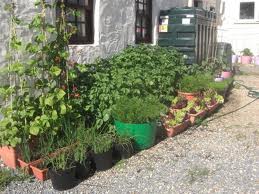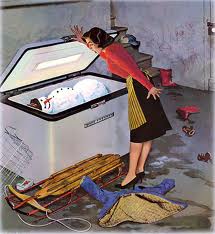As we make our New Year’s Resolutions, one good one to keep in mind is that of producing or keeping more of your own food. Now is the perfect time to plan for the coming growing season. While it would be great to provide all our own food for the year, taking on this entire task alone is unrealistic. Many a well-meaning family has tried, only to become overwhelmed and give up. In today’s world, it is very unlikely that one would be able to provide all your own food, but one can certainly provide a number of key items for your family, and put a bit of a dent in your grocery bill. The secret is using baby steps. Master one project at a time, try adding something new after your first successes.
Winter is traditionally a time of planning and dreaming about the summer garden. Seed catalogues have arrived, and the chilly days and slower pace are perfect for sitting and musing about warmer days to come. But it is also the time when your family is eating the foods that you’re going to want to put up for yourself. Now is the time to pay attention and take note of what you are eating and buying at the grocery or market. Local, seasonal eating takes practice, and working with what you are already doing is going to make the transition much easier. Keep lists or a notebook if you need to, or keep you grocery receipts. See what veggies you are buying, which canned goods, which meats you eat the most often. These are the foods to concentrate on when planning to provide your own.
And be honest with yourself: One of the first canning projects many people undertake is cucumber pickles or relish. Yummy as this is, it’s not really going to mean much to your family if they really don’t eat them anyway. Find yourself eating more salsa instead? Marinara sauce? Go for these items when canning instead. Certainly, eating local and seasonal means learning how to eat what’s available and keep it interesting, but again, successes with your staple items will inspire you and your family to expand your palate and diet.
 How do you use fruit? Do you enjoy bread and jam, or chunky fruit with your oatmeal or yogurt? Do you want whole strawberries for your Christmas cheesecake? Or do you enjoy strawberry sauce over ice cream? Or both? Keep these things in mind when planning how you can best prepare these items when preserving for yourself.
How do you use fruit? Do you enjoy bread and jam, or chunky fruit with your oatmeal or yogurt? Do you want whole strawberries for your Christmas cheesecake? Or do you enjoy strawberry sauce over ice cream? Or both? Keep these things in mind when planning how you can best prepare these items when preserving for yourself.
When you’re shopping at the store, stop and notice all the different ways foods are presented for you to buy: You’ll find items fresh, frozen, canned, dried. How do you use these foods?
Once you’ve figured out which foods you use the most and want to try to provide for yourself or preserve for winter use, it’s time to come up with a realistic plan. Again, using baby steps, figure out which foods you want to grow, which you should start buying in bulk to save money, and which you should purchase in bulk locally and put up for the winter.
Break it up into two groups: What you can grow, what you can buy in bulk to can or freeze to put up yourself.
Consider what you have available in terms of space to grow, freezer and pantry space. If you have adequate space to grow some food, you can put some energy into that. If you have freezer and pantry space, consider focusing on preserving foods you use often, and look for ways to save money by using your freezer.
Keep in mind that freezers are vulnerable to power outages, though these usually occur during winter months when the cold weather gives you an advantage.
Try to keep your freezer is in a cooler space (ours are outside our home. My second choice for placement within the house is my pantry, which is off my unheated porch just a hair warmer than outside). They come in many shapes and sizes, and often can be found rather in expensive in the classifieds.
If you don’t have an extra freezer, plan to dehydrate or can your foods. Canning really is optimal, because the foods are safe from power outages. You will of course still need storage space, for the jars both full and empty, but we Americans are accustomed to accumulation, and this for once is for a very useful cause. If you don’t have a collection of jars, put the word out with your friends that you are looking, and keep an eye on the classifieds, often people will sell their entire collections at once. Canning kettles are fairly inexpensive, and a good one will last you for years. And they come in different sizes, depending on how much space you have on your stove top.
A small dehydrator will not cost you much and can really help with saving summer bounty. Kids love dried apples and peaches, and many other fruits and veggies dry well to be used later on. And you can save a ton of money drying your own herbs. Fo’ schizzle.
 Think about this for your meats, too. Often you can get a discount if you buy in bulk. Sometimes you need to find the right supplier, not all smaller operations can afford a substantial discount. Or you may be able to buy whole or half animals, this is usually cheaper than the retail prices even with discount.
Think about this for your meats, too. Often you can get a discount if you buy in bulk. Sometimes you need to find the right supplier, not all smaller operations can afford a substantial discount. Or you may be able to buy whole or half animals, this is usually cheaper than the retail prices even with discount.
A family of six can easily take down at least two pigs a year, and it is so awfully handy to have it all in the freezer, rather than running to the store every week! Buying a whole pig twice a year is a real money-saver. Look into doing this with whatever meats your family enjoys.

Buying fruits like apples, peaches, pears and plums and canning or freezing for the winter is great for both better product and saving money. These can be used all year for so many things, and again so handy to have your own stash.
Berries freeze well alone or can be made into jam. Jam can be used for cooking in a variety of ways, it’s becoming a real staple condiment in a true Foodista’s kitchen (sorry, Guys! If you’re going to do it, you’re still a Foodista. There is no ‘Foodistus’).
Think pragmatically when planning what to grow. Balance how much you consume with how much you can effectively grow. Tomatoes are great, but they can be a lot of work and take up space, and if you need to can 50-100 jars, trying to grow that many if you have limited space may be impractical. Buy those in bulk at market instead. Grow for yourself instead things like salad greens and herbs, which can be pricey at market but fairly easy to grow.
When growing lettuces, ask around and make sure you get good varieties that do not bolt or get bitter easily. Do not plant Black-Seeded Simpson. Keep replanting every two weeks starting in early spring until it starts getting hot in June. Plant herbs in spring and keep cutting and drying your leaves so they keep growing back all summer. Bring them indoors if you want in the Fall.
Other items to grow that use less space and yield well are summer squashes, green beans, beets chard, collard and other greens, and scallions. Onions can work out well, too, if you have the time (or a good trick) to keep them weeded. Again, it all depends on how much room and fertility you have. But in general, plan to buy-in and put up other veggies like sweet corn, winter squashes, melons, cukes, peppers, eggplants, etc. These items take more attention and space to grow, and might not be the best choice for beginners who are also trying to put up their own food.
Some of your pantry staples can be gotten in bulk, as well. Check around and see if your community has a co-operative buying club or similar venture. Flour, sugar, pasta, dried beans, rice, etc. are also handy to have in storage. But do take caution, and keep your pantry items well-sealed against grain moths and moisture, both of which will ruin your foods. Again, planning is important when taking on the responsibility of storing your own food, and it must be kept healthy and safe.
Do take this seriously: It will do you no good to go through all the trouble of collecting food all summer if it is tainted in storage. This means diligence.
Make sure your freezers are running properly. And plugged in. Make sure your children do not leave the doors open.
Your pantry must be cool, dark and dry, but shouldn’t freeze. Dehydrated items must stay dry until use. Canning jar lids should always be double-checked for a tight seal before opening to use, and get in the habit of sniffing each and every jar before you serve. But these things re just that– habits. You’ll get used to doing these things, and they will become second-nature. Every little bit takes you one step closer to food independence.
That’s enough for now. Next few posts we’ll talk about different ways you can procure your own food in different living situations. Whether you live in an apartment in town, in a house in suburbia or out in the sticks, there are different things you can do to get more of your own food locally and in season. So stay tuned and start planning!












Dec 30, 2011 @ 22:28:28
I love your pork taste guide!
Feb 04, 2013 @ 19:29:52
Reblogged this on Sunny Hill Farm Blog and commented:
Re-posting cause it’s that time of year again…